Electro-rock duo Boom Boom Satellites have remixed "A Fact of Life" by screamo outfit Fact, and the video is a fiendish feast of Noh-inspired abstract dance.
+ Video
Electro-rock duo Boom Boom Satellites have remixed "A Fact of Life" by screamo outfit Fact, and the video is a fiendish feast of Noh-inspired abstract dance.
+ Video
Kenbikyo Mushi No Zu ("Illustrations of Microscopic Insects"), a scroll published in 1860, depicts a lively parade of creepy-crawlies as viewed through a microscope. Although most of the insects pictured can actually be seen with the naked eye, the artist's use of a microscope -- still a relatively unusual instrument in Japan in those days -- added a great level of detail to the drawings and made it a rather unique visual work.
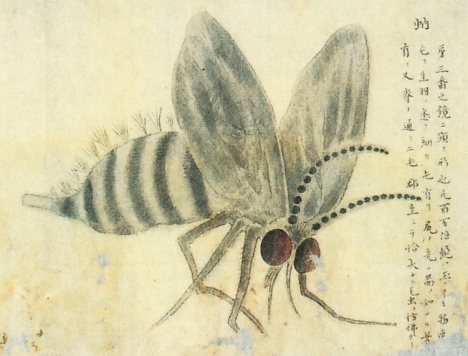
Gnat [+]
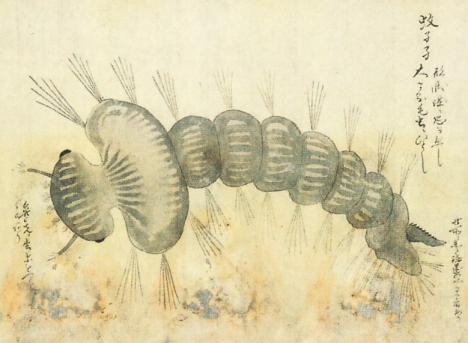
Mosquito larva [+]
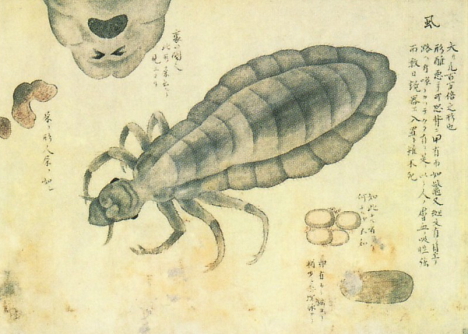
Louse [+]
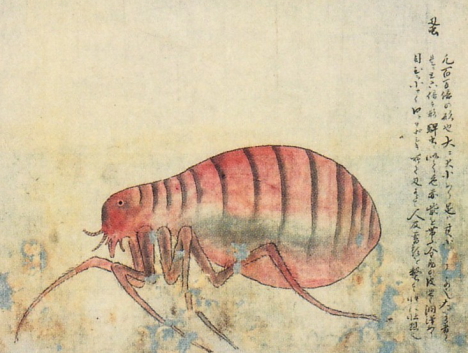
Flea [+]
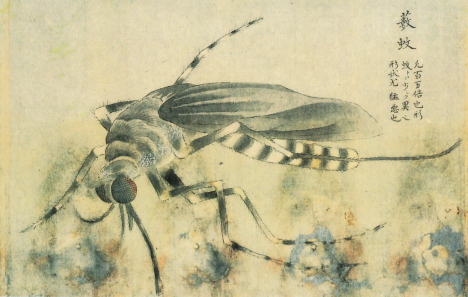
Striped mosquito [+]
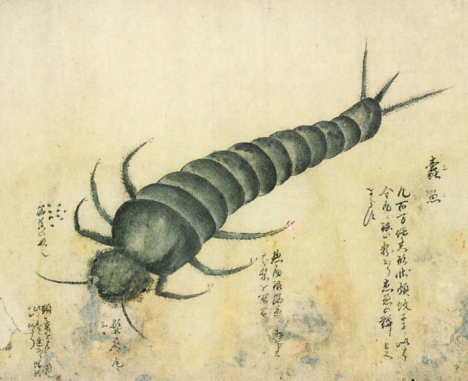
Silverfish [+]
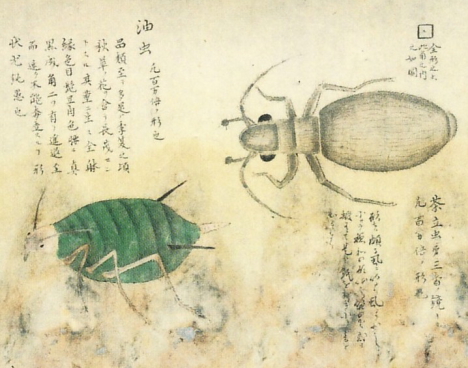
Aphid (left), Psocid (right) [+]
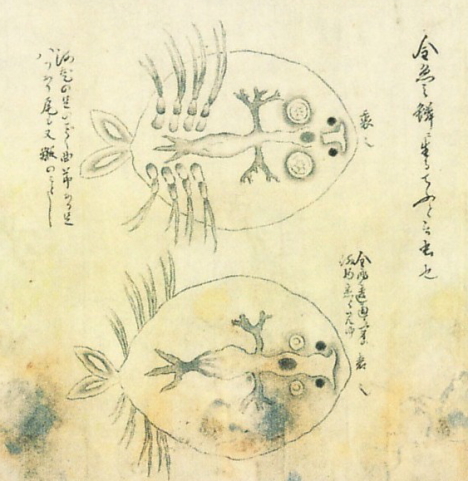
Fish louse [+]
The first microscope was brought to Japan in the mid-18th century (about 150 years after its invention in Europe) by Dutch traders at Nagasaki, and it was introduced to the public by pharmacologist Rishun Goto in a 1765 book entitled Oranda-banashi ("Story of Things Dutch"). Soon afterward, production of the first Japanese microscopes began in Osaka.
In 1787, Churyo Morishima, a scholar of Western science, published Komo Zatsuwa ("Sayings of the Dutch"), which described the lifestyle and customs of the Dutch in Japan. The document included a section devoted to the microscope, complete with illustrations of insects as seen through the device.
As Japanese microscope technology developed, the device became a popular attraction at carnival sideshows. One notable sideshow in Nagoya in 1820 put an assortment of fleas, lice, mosquitoes and other bugs on public display. According to written records of the event, many spectators shuddered with fear as they peered through the microscopes, which made the creatures look as large as a human hand. Others viewed the microscopes with excitement, as they offered a glimpse into a previously unknown world.
The Tohoku University Library houses the original copy of the Kenbikyo Mushi No Zu scroll.
[See also: Mythical 16th-century disease critters]
+ Video
The Open Reel Ensemble adds a unique twist to the old-school art of reel-to-reel tape scratching, with USB controllers that manipulate the switches inside the tape decks and with solenoids that create vibrato effects by tweaking the speed of the tape as it passes over the heads.
In 1974, home appliance retailer Yamagiwa Corporation printed 1,974 copies of a promotional poster featuring a Jesus portrait by noted pop artist Tadanori Yokoo. The poster depicts Christ in front of a colorful mandala-like pattern centered around an inverted triangle, which Yokoo described as being a Tantric symbol of Shakti, the feminine creative energy of the universe, though it could just as well represent the Holy Trinity.
(*Auction info deleted.)
Lurking in the halls of Buddhist temples and museums across Japan are a host of monster mummies -- the preserved remains of demons, mermaids, kappa, tengu, raijū, and even human monks. Here are a few remarkable specimens for the adventurous and brave at heart.
- Demon mummies
It might seem odd that Buddhist temples in Japan house the occasional stray mummified demon (oni), but then again it probably makes sense to keep them off the streets and under the watchful eye of a priest.

Three-faced demon head at Zengyōji temple [Photos]
Zengyōji (善行寺) temple in the city of Kanazawa (Ishikawa prefecture) is home to the mummified head of a three-faced demon. Legend has it that a resident priest discovered the mummy in a temple storage chamber in the early 18th century. Imagine his surprise.
Nobody knows where the demon head came from, nor how or why it ended up in storage.
The mummified head has two overlapping faces up front, with another one (resembling that of a kappa) situated in back. The temple puts the head on public display each year around the spring equinox.
 Another mysterious demon mummy can be found at Daijōin temple in the town of Usa (Oita prefecture).
Another mysterious demon mummy can be found at Daijōin temple in the town of Usa (Oita prefecture).
The mummy is said to have once been the treasured heirloom of a noble family. But after suffering some sort of misfortune, the family was forced to get rid of it.
The demon mummy changed owners several times before ending up in the hands of a Daijōin temple parishioner in 1925. After the parishioner fell extremely ill, the mummy was suspected of being cursed.
The parishioner quickly recovered from his illness after the mummy was placed in the care of the temple. It has remained there ever since. Today the enshrined demon mummy of Daijōin temple is revered as a sacred object.
A much smaller mummy -- said to be that of a baby demon -- was once in the possession of Rakanji Temple at Yabakei (Oita prefecture).
Unfortunately, it was destroyed in a fire in 1943.
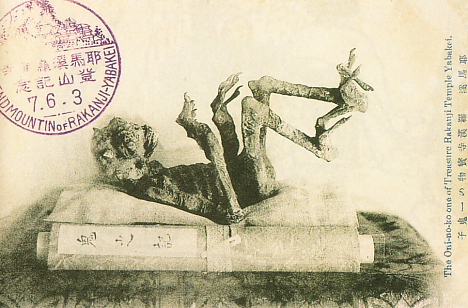
Baby demon mummy at Rakanji temple
* * * * *
- Mermaid mummies
In Edo-period Japan -- particularly in the 18th and 19th centuries -- mermaid mummies were a common sight at popular sideshow carnivals called misemono. Over time, the practice of mermaid mummification blossomed into an art form as fishermen perfected techniques for stitching the heads and upper bodies of monkeys onto the bodies of fish.
The mummy pictured below is a prime example of a carnival mermaid. It appears to consists of fish and other animal parts held together with string and paper.

Mermaid mummy at the National Museum of Ethnology, Leiden
The mummified creature was obtained by Jan Cock Blomhoff while serving as director of Dejima, the Dutch trading colony at Nagasaki harbor, from 1817 to 1824. It now resides at the National Museum of Ethnology in Leiden.
Another old mermaid mummy exhibited at a museum in Tokyo several years ago appears to belong to the founder of the Harano Agricultural Museum.

Mysterious mermaid mummy
The mummy's origin is unknown, but the collector says it was found in a wooden box that contained passages from a Buddhist sutra written in Sanskrit. Also in the box was a photograph of the mermaid and a note claiming it belonged to a man from Wakayama prefecture.
* * * * *
- Kappa mummies
Like the mermaid mummies, many kappa (river imp) mummies are thought to have been crafted by Edo-period artists using parts of animals ranging from monkeys and owls to stingrays.

Kappa mummy at the National Museum of Ethnology, Leiden (Netherlands)
This mummified kappa, which now resides in a Dutch museum, appears to consist of various animal parts put together in a seamless whole. It is believed to have been created for the purpose of carnival entertainment in the Edo period.
Another mummified kappa can be found at Zuiryūji temple in Osaka.
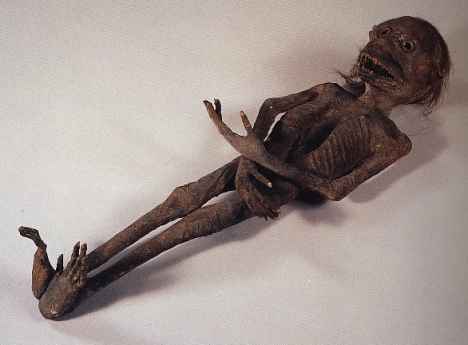
Kappa mummy at Zuiryūji Temple, Osaka [Photo]
The 70-centimeter long humanoid purportedly dates back to 1682.
Another notable kappa mummy can be seen in a seemingly unlikely place -- at a sake brewery in the town of Imari (Saga prefecture).

Kappa mummy at Matsuura Brewery
According to a company brochure, the mummified kappa was discovered inside a wooden box that carpenters found hidden in the ceiling when replacing the roof over 50 years ago.
Reckoning the creature was an old curiosity their ancestors had passed down for generations, the company owners built a small altar and enshrined the kappa mummy as a river god.
>>> Read more about the kappa.
* * * * *
- Raijū
With a limited scientific understanding of the sky above, the common person in Edo-period Japan looked upward with great awe and mystery. Supernatural creatures called raijū (雷獣) -- lit. "thunder beast" -- were believed to inhabit rain clouds and occasionally fall to earth during lightning strikes.
The earliest known written records of the raijū date as far back as the late 18th century, though the creature appears to borrow characteristics from the nue -- a cloud-dwelling, illness-inducing chimera first described in The Tale of the Heike, a 12th-century historical epic.
Details about the raijū's appearance vary. Some Edo-period documents claim the raijū resembled a squirrel, cat or weasel, while others describe it as being shaped more like a crab or seahorse.


Raijū depicted in the Kanda-Jihitsu (ca. 1800) // Raijū seen in Tottori, 1791
However, most descriptions agree that the raijū had webbed fingers, sharp claws, and long fangs that, by some accounts, could shoot lightning. The beast also sometimes appeared with six legs and/or three tails, suggesting the ability to shape-shift.
One illustrated document tells of a raijū that fell from the sky during a violent storm on the night of June 15, 1796 in Higo-kuni (present-day Kumamoto prefecture).

Illustration of raijū encountered on June 15, 1796
Here, the raijū is described as a crab-like creature with a coat of black fur measuring about 11 centimeters (4 inches) thick.
Another notorious encounter took place in the Tsukiji area of Edo on August 17, 1823. Two versions of the incident offer different descriptions of the beast.

Raijū encounter, August 17, 1823 - Version 1
One document depicts the raijū as being the size of a cat or weasel, with one big bulging eye and a single long horn, like that of a bull or rhino, projecting forward from the top of its head.

Raijū encounter, August 17, 1823 - Version 2
In the other account, the raijū has a more roundish look and lacks the pointy horn.
In Volume 2 of Kasshi Yawa ("Tales of the Night of the Rat"), a series of essays depicting ordinary life in Edo, author Matsuura Seizan writes that it was not uncommon for cat-like creatures to fall from the sky during thunderstorms. The volume includes the story of a family who boiled and ate one such creature after it crashed down onto their roof.
Given the frequency of raijū sightings, it should come as no surprise that a few mummies have turned up.
In the 1960s, Yūzanji temple in Iwate prefecture received a raijū mummy as a gift from a parishioner. The origin of the mummy, as well as how the parishioner obtained it, is a mystery.

Raijū mummy at Yūzanji temple
The mummy looks like that of a cat at first glance, but the legs are rather long and the skull has no visible eye sockets.

Raijū mummy at Saishōji temple [Photo]
A similar raijū mummy is on display at Saishōji temple in Niigata prefecture.
* * * * *
- Tengu mummy
Another legendary supernatural sky creature is the tengu, a dangerous demon often depicted in art as being part human and part bird. The Hachinohe Museum (Aomori prefecture) in northern Japan is home to a tengu mummy, which is said to have once belonged to Nambu Nobuyori, a Nambu clan leader who ruled the Hachinohe domain in the mid-18th century.

Tengu mummy at Hachinohe Museum
The mummy, which appears to have a humanoid head and the feathers and feet of a bird, is believed to have originated in the town of Nobeoka (Miyazaki prefecture) in southern Japan. Theories suggest the tengu mummy made its way north after being passed around between members of Japan's ruling samurai families, some of whom were deeply interested in collecting and trading these curiosities.
* * * * *
- Self-mummified monks
A few Buddhist temples in northern Japan are home to "living mummies" known as sokushinbutsu (即身仏). The preserved bodies are purportedly those of ascetic monks who willingly mummified themselves in the quest for nirvana.
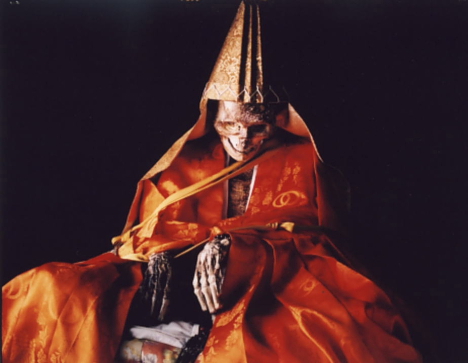
Shinnyokai-Shonin "living mummy" at Dainichibo Temple (Yamagata prefecture)
To become a living mummy, monks had to undergo a long and grueling three-step process.
Step 1: For 1,000 days, the monks would eat a special diet of nuts and seeds, and engage in rigorous physical training to strip the body of fat.

Tetsumonkai-Shonin "living mummy" at Churenji temple (Yamagata prefecture)
Step 2: For another 1,000 days, they would eat only bark and roots in gradually diminishing amounts. Toward the end, they would start drinking tea made from the sap of the urushi tree, a poisonous substance normally used to make Japanese lacquer bowls, which caused further loss of bodily fluid. The tea was brewed with water from a sacred spring at Mt. Yudono, which is now known to contain a high level of arsenic. The concoction created a germ-free environment within the body and helped preserve whatever meat was left on the bone.

Arisada Hōin, 300-yr-old "living mummy" at Kanshūji temple (Fukushima)
Step 3: Finally, the monks would retreat to a cramped underground chamber connected to the surface by a tiny bamboo air pipe. There, they would meditate until dying, at which point they were sealed in their tomb. After 1,000 days, they were dug up and cleaned. If the body remained well-preserved, the monk was deemed a living mummy.
Unfortunately, most who attempted self-mummification were unsuccessful, but the few who succeeded achieved Buddha status and were enshrined at temples. As many as two dozen of these living mummies are in the care of temples in northern Honshu.
The Japanese government outlawed the practice of self-mummification in the late 19th century.
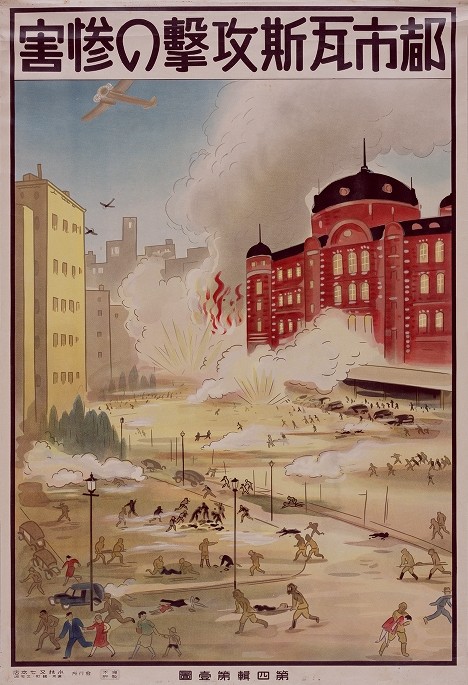
Devastation of Urban Gas Attack
In 1938, the Japanese Red Cross worked with government authorities to create a series of posters to teach the public about the new Anti-Aircraft Defense Law, which was enacted in seeming anticipation of air strikes following the outbreak of the Japan-China War (1937-1945). Among other things, the new law required citizens to take protective measures against gas attacks and prepare for disinfection, evacuation and relief. For the government, one purpose of the posters -- which were created as part of a military exhibition at the Red Cross Museum -- was to instill a pattern of "anti-aircraft defense thought" among the population.
- - - - -
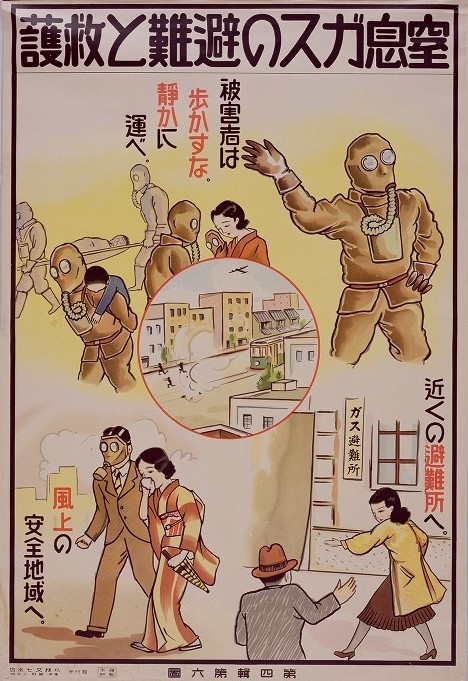
Asphyxiant Gas: Evacuation and Aid
Do not allow victims to walk. Carry them gently.
Head to a nearby shelter.
Move to a safe location upwind.
- - - - -
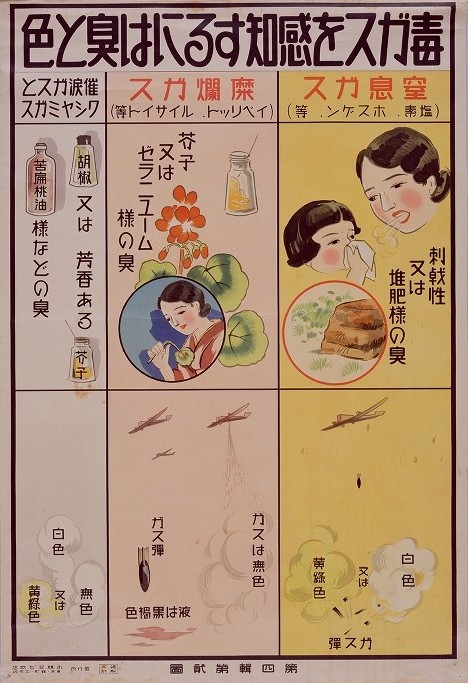
Gas Detection: Smell and Color
- Asphyxiant gas (chlorine, phosgene, etc.): Pungent or hay-like odor. White or yellowish in color.
- Blister gas (yperite/mustard gas, lewisite, etc.): Mustard or geranium-like odor. Colorless in gas form, reddish-brown in liquid form.
- Tear gas and sneezing gas: Odor resembles pepper, spicy mustard or bitter almond oil. White, yellow or colorless.
- - - - -
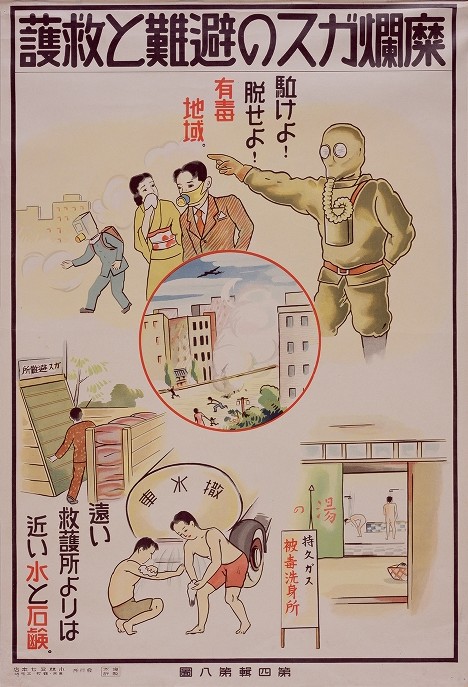
Blister Gas: Evacuation and Aid
Toxic area! Run! Flee!
Better to seek soap and water nearby than to travel to an aid center far away.
- - - - -
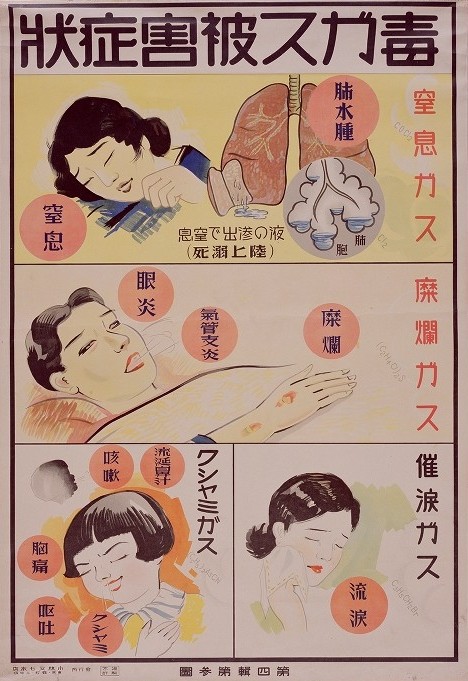
Poison Gas Symptoms
- Asphyxiant gas: Accumulation of fluid in lungs/ Suffocation (dry drowning)
- Blister gas: Blisters/ Respiratory inflammation/ Inflammation of the eyes
- Tear gas: Watery eyes
- Sneezing gas: Salivation and nasal discharge/ Coughing/ Chest pain/ Vomiting/ Sneezing
- - - - -
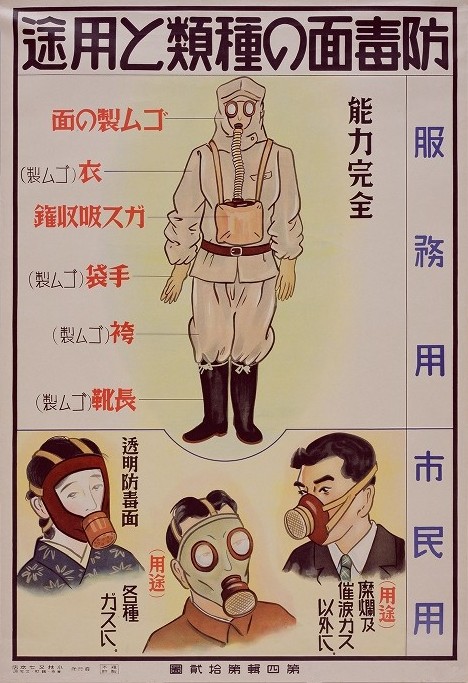
Gas Masks: Type and Purpose
Military use
- Full protection
- Rubber face mask
- Body suit (rubber)
- Filter
- Gloves (rubber)
- Boots (rubber)
Civilian use
- (Right) For any gas except blister gas and tear gas
- (Center) For various types of gas
- (Left) Transparent visor
- - - - -
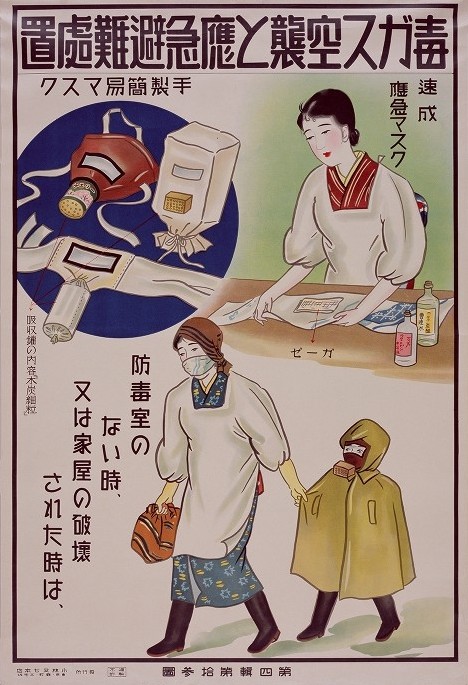
Gas Attack and Emergency Escape
Quick emergency mask
- Gauze
- 2% sodium carbonate/water solution
- 10% urotropin-water solution
Simple homemade masks
- Can contains charcoal particles
Use when no gas shelter is available or when your home has been destroyed.
- - - - -
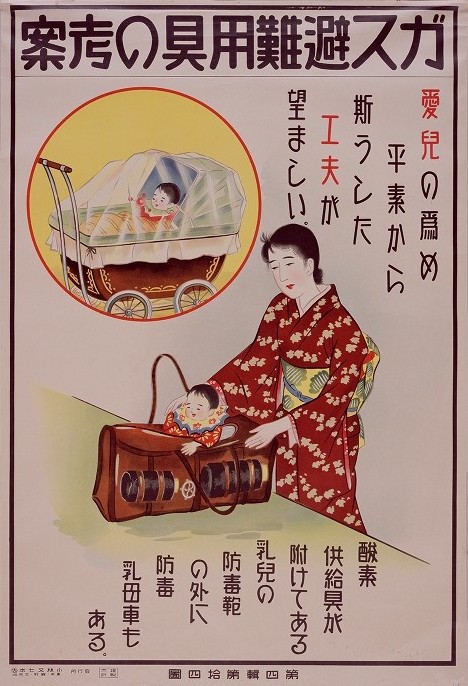
Making Gas Protection Tools
For small children, prepare a gas-tight baby carriage or bag with attached oxygen supply.
Keep this type of protection on hand at all times.
- - - - -
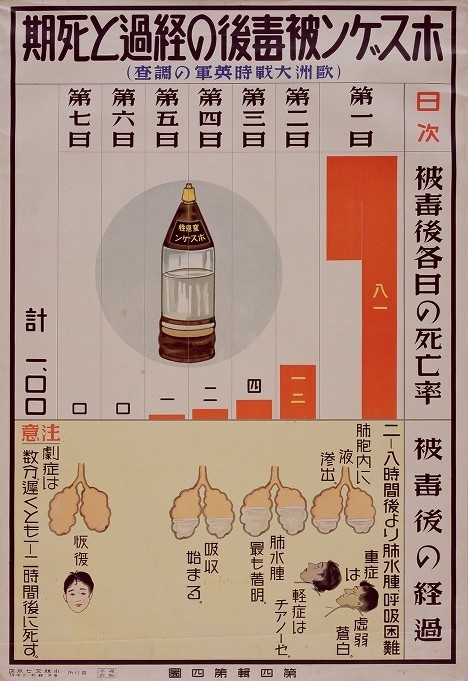
Phosgene Poisoning: Progression of Symptoms and Death
(Based on British Army research during the War in Europe)
Death rate by day:
- Day 1: 81%
- Day 2: 12%
- Day 3: 4%
- Day 4: 2%
- Day 5: 1%
Progression of symptoms
- Fluid begins to accumulate in lungs within 2 to 8 hours, causing difficulty in breathing.
- Fluid seeps into alveoli.
- Victim turns pale in mild cases, ashen white in severe cases.
- Fluid in lungs becomes increasingly evident.
- Absorption begins.
- Recovery.
Caution: Sudden death may occur within minutes or hours.
- - - - -
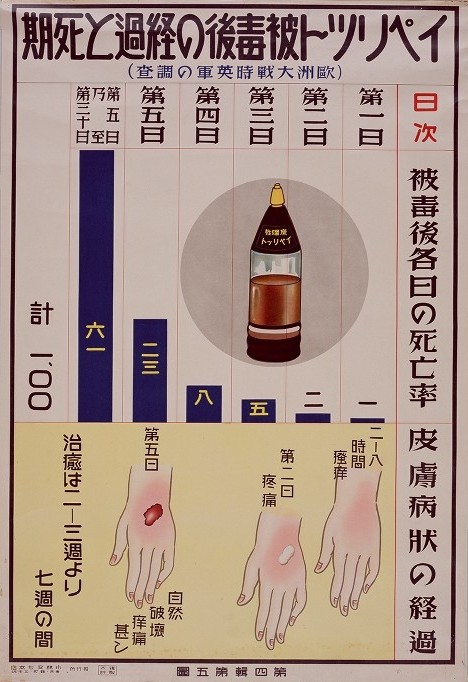
Yperite (Mustard Gas): Progression of Symptoms and Death
(Based on British Army research during the War in Europe)
Death rate by day
- Day 1: 1%
- Day 2: 2%
- Day 3: 5%
- Day 4: 8%
- Day 5: 23%
- Day 6 to 30: 61%
Progression of symptoms
- Initial 2 to 8 hours: Itchiness
- Day 2: Pain
- Day 5: Rupturing of blisters, intense itchiness
Recovery takes 2 to 7 weeks.
- - - - -
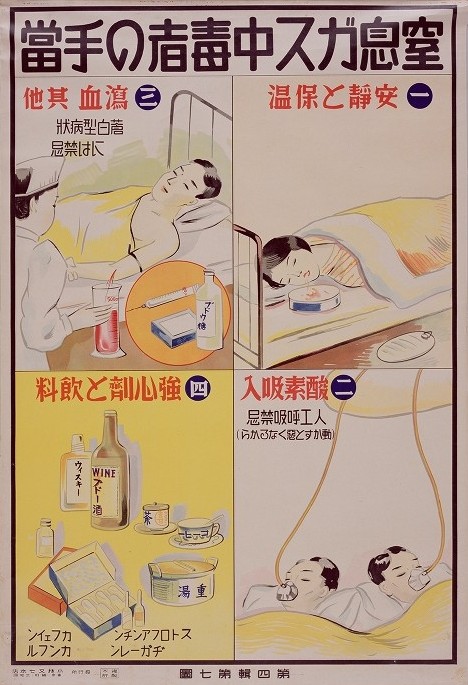
Treatment of Asphyxiant Gas Victims
1. Bed rest and warmth
2. Fresh oxygen supply
- Do not use an artificial respirator (victim may worsen if moved).
3. Blood draw
- Do not perform if the victim is pale.
4. Heart stimulants and beverages
- Strophantin/ Digitoxin/ Caffeine/ Camphor
- - - - -
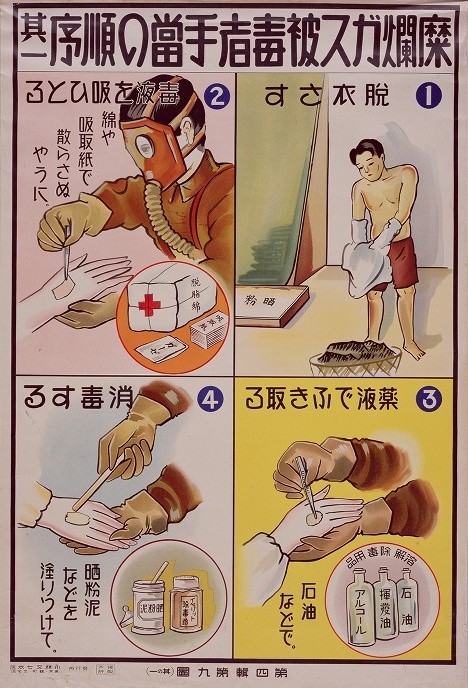
Treatment of Blister Gas Victims (Part 1)
1. Undress.
2. Clean the skin of poisonous substance. (Use cotton or absorbent paper.)
3. Apply solvent (oil, benzene or alcohol).
4. Sterilize. (Apply calcium hypochlorite.)
- - - - -
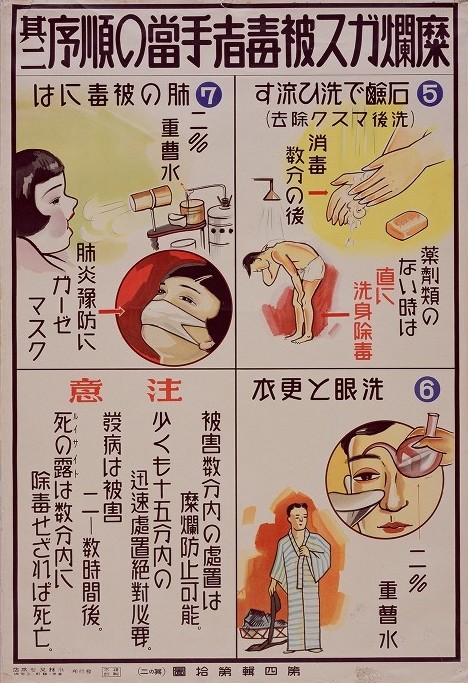
Treatment of Blister Gas Victims (Part 2)
5. Wash thoroughly with soap. (Dispose of mask after washing.) Decontaminate with water if no medicine is available.
6. Wash eyes (2% baking soda/water solution) and put on clean clothes.
7. For poisoned lungs...
2% baking soda/water solution
Gauze mask
Caution
- Immediate action required, at least within 15 minutes of exposure.
- Treatment within the first few minutes of exposure may prevent the development of blisters.
- Symptoms begin to show within a few hours.
- Failure to quickly remove poison from the skin will result in death.
- - - - -
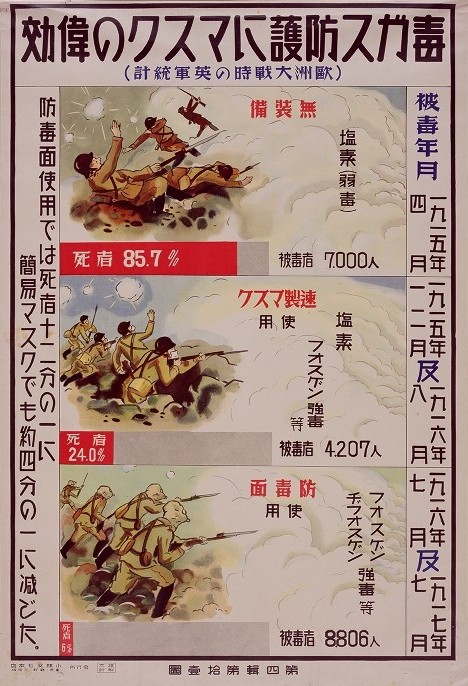
Effectiveness of Gas Masks
(Based on British Army statistics from the War in Europe)
- April 1915/ No masks/ Chlorine gas (weak)/ 7,000 casualties/ 85.7% casualty rate
- December 1915 - August 1916/ Primitive masks (cloth)/ Chlorine, phosgene gas (strong)/ 4,207 casualties/ 24% casualty rate
- July 1916 - July 1917/ Canister gas masks/ Phosgene, diphosgene gas (strong)/ 8,806 casualties/ 6% casualty rate
Canister gas masks reduced the casualty rate by a factor of 12. Primitive masks reduced the casualty rate by a factor of 4.
- - - - -
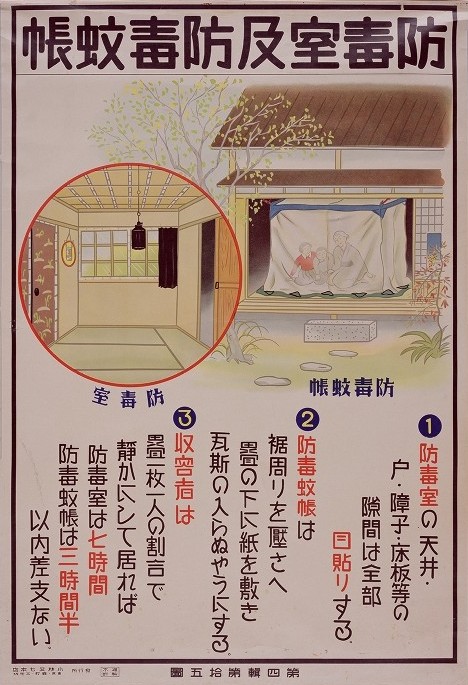
Gas-tight Room and Mosquito Net
1. Seal all gaps in the ceiling, doors and floor to create a gas-tight room.
2. To create a gas-tight tent, keep the bottom hem of the mosquito net pressed to the floor and place a layer of paper over the tatami.
3. Assuming there is one person per tatami mat and you stay calm, you can remain safely in the room for 7 hours and in the tent for 3 hours.
- - - - -
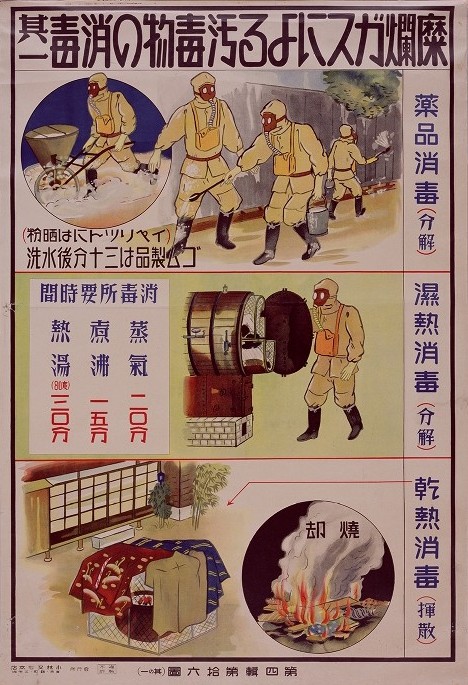
Blister Gas Decontamination (Part 1)
Chemical treatment
- For mustard gas, use calcium hypochlorite.
- Wash rubber products 30 minutes after exposure.
Wet-heat treatment
- Steam: 20 minutes
- Boil: 15 minutes
- Hot water (80 degrees Celsius): 30 minutes
Dry-heat treatment
- Incinerate
- - - - -
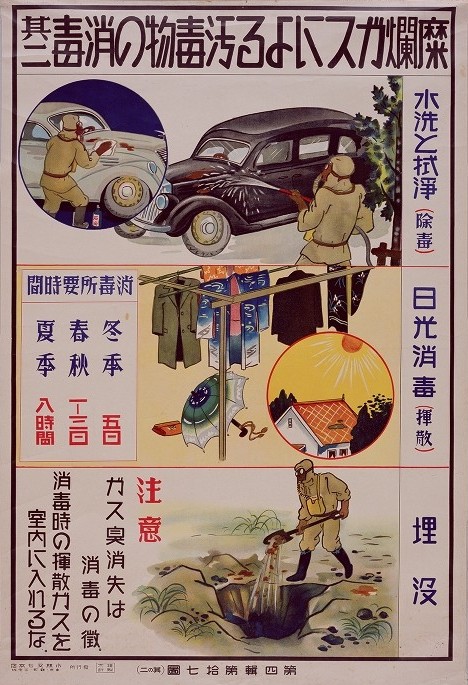
Blister Gas Decontamination (Part 2)
Wash and wipe
Sun-dry
- Winter: 5 days
- Spring/Autumn: 1 to 3 days
- Summer: 8 hours
Burial
- Disappearance of gas odor is a sign of decontamination.
- Do not allow residual gas indoors when decontaminating.
[Link: National Archives of Japan]
Walk the stairwells of some of Tokyo's oldest department stores and you will find some remarkable ammonite fossils embedded in the marble walls.

Mitsukoshi (Shinjuku)
Ammonites are hard-shelled, squid-like creatures that inhabited the world's oceans for nearly 350 million years, until they died out with the dinosaurs about 65 million years ago. They are known only from the fossilized remains of their spiral-shaped shells.

Artist's reconstruction of ammonites
The fossil-rich marble staircases at the Shinjuku Mitsukoshi department store, built in 1929, are embedded with numerous ammonite specimens, some of which are indicated with arrows and labels.


Mitsukoshi (Shinjuku)

Mitsukoshi (Shinjuku)
Likewise, the magnificent marble staircase at the Nihonbashi Mitsukoshi department store, constructed in 1914, is also loaded with ammonite fossils.

Mitsukoshi (Nihonbashi)

Mitsukoshi (Nihonbashi)
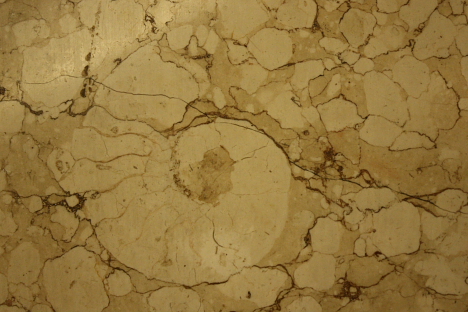
Mitsukoshi (Nihonbashi)
Still more fossils can be found in the marble stairwells and columns inside the Nihonbashi Takashimaya department store, constructed in 1933.

Takashimaya (Nihonbashi)


Takashimaya (Nihonbashi)

Takashimaya (Nihonbashi)
The Ueno Matsuzakaya department store, built in 1929, includes marble staircases, but there is no trace of ammonites.

Matsuzakaya (Ueno)
However, a rare fossil of what is believed to be a type of brain coral is embedded in the wall near the third floor.
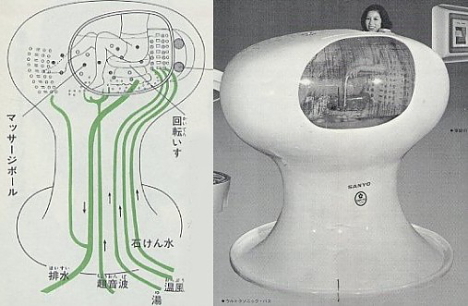
At the 1970 World Expo in Osaka, consumer electronics maker Sanyo demonstrated their vision for the future by showcasing a series of appliances they thought would populate the home of tomorrow. Included was the Ultrasonic Bath, a pod-like human washing machine that cleans, massages and dries the user in a fully automated 15-minute process.
Using a ladder, the bather climbs in through an opening on top of the machine, which stands about 2 meters (6 ft) tall. Once the desired water temperature is set and the main switch is activated, the pre-rinse cycle starts, spraying the user with jets of hot water for 5 minutes.

Next, the chamber fills up with hot water for a 3-minute massage bath. High-pressure jets create a powerful whirlpool, and scores of knobby, golf ball-sized "massage balls" suspended in the water pelt the body, delivering a vigorous massage intended to stimulate blood circulation. An ultrasonic wave generator creates a ticklish cloud of tiny air bubbles that lift dirt from the skin.
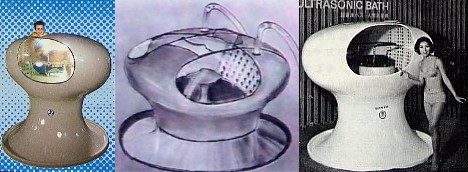
The bath is then followed by a 2-minute hot rinse cycle. Finally, a 5-minute dry cycle blasts the user with warm air, while a flood of infrared and ultraviolet light destroys any lingering germs.
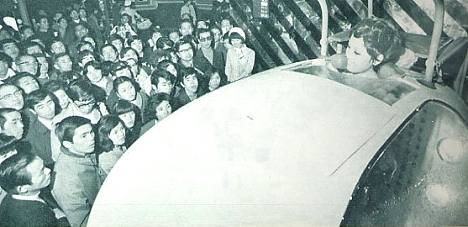
Developed as a concept model, the Ultrasonic Bath never made it into our homes. Several years ago, however, Sanyo unveiled the $50,000 HIRB ("Human In Roll-lo Bathing") system, a compact version designed for use in elderly homes.
[Link]
Via The Echinoblog's profile of starfish-themed monsters in Japanese cinema come these classic clips of Starfish Hitler, a Government of Darkness (G.O.D.) villain who battled superhero Kamen Rider X on TV in 1974.
+ Part 1: Kamen Rider X vs Starfish Hitler
+ Part 2: Kamen Rider X vs Starfish Hitler
[Link: The Echinoblog]